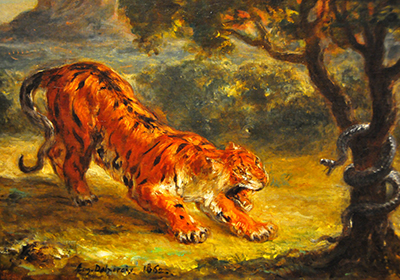Tiger and Snake, 1862, is a memorable artwork by Eugene Delacroix which now resides within the collection of the National Gallery of Art in the US, where is has been for over a century.
The gallery does not, unfortunately, provide too much information on this painting but we can gather much about it based on the artist's other depictions of lions and tigers. This piece is unique in how it pits two creatures against each other, where as normally Delacroix would actually have animals up against humans instead. He seemed to normally want the animal to actually overcome the human, in most cases, but here we are not so sure as to where his loyalties lie. We do know that he studied lions and tigers in French zoos, but perhaps snakes were a little easier to come across. The artwork, Tiger and Snake, is just over 40cm in width, making it relatively small for one of the artist's many oil paintings.
The artist loved emotion and also movement within his paintings and he would go about discovering which content could best deliver these elements. There was always something raw about wild animals and he became interested in their unique attributes. He found that they could work well in both oils as well as watercolours, though most of the studies that he produced of them was done so in small sketchbooks using charcoal. This method was quicker and easier, as working with animals, even those trapped in zoo enclosures, was always going to be difficult for a painter. He developed his understanding and became more confident over time, continually adding to his existing knowledge as well as understanding which style of work was more easy to sell to his supportive patrons across France.
Delacroix normally pictured animals within natural surroundings, such as the artwork found here, but his understanding of these creatures was actually derived from studying them in local French zoos. He would sit for hours, sometimes by himself just after the establishments had opened, and study their bodies with great attention, sometimes making sketches which he would review at a later date. His main concern was to understand the unique aspects of each one and also to witness their different behaviours in person so that his later use of them in his paintings was as believable and accurate as possible. In some examples he would actually place several animals together, as found here, and then create his own imaginary interaction based on what he had already learnt about each one from a more enclosed environment. We must remember that access to knowledge and experience of exotic creatures was much harder to arrange in past centuries, and so artists would have to be fairly pro-active in that regard.




